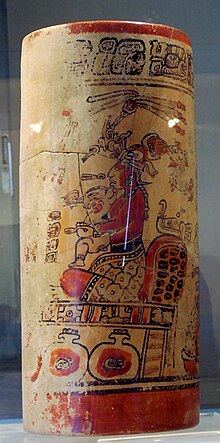
Back Mayakeramik Danish Cerámica maya Spanish Céramiques mayas French Керамика майя Russian Кераміка мая Ukrainian
This article needs additional citations for verification. (September 2013) |

Maya ceramics are ceramics produced in the Pre-Columbian Maya culture of Mesoamerica. The vessels used different colors, sizes, and had varied purposes. Vessels for the elite could be painted with very detailed scenes, while utilitarian vessels were undecorated or much simpler. Elite pottery, usually in the form of straight-sided beakers called "vases", used for drinking, was placed in burials, giving a number of survivals in good condition. Individual examples include the Princeton Vase and the Fenton Vase.
Used for a plethora of daily activities, such as the storage of food and beverages, ceramics were also a canvas of commemoration. There were three main types of ceramics used in daily life: bowls, plates, and cylinders. They were often monochrome, meaning that only one type of mineral slip was used.[1] Polychrome pottery was more complex in nature and therefore more commonly used by the elite. Not only was polychrome pottery used as decoration, it was also used as a form of social currency—a physical display of status and others' approval.[2]
As time progressed, various features were added to ceramics to go beyond the fundamental needs of vessels; For example, pellets were put in larger bowls to not only serve as something to hold food, but would also become instruments used in the same feasts.[3]
Archaeological evidence has been found that suggests ceramics were used for industrial purposes. The discovery of highly uniform ceramic cylinders along with tools used in the production of salt indicate that the ceramics were used to mass-produce salt from brine.[4]
Surveys of Maya ceramics a major part of the ongoing controversy over the degree of elite political control over aspects the subsistence economy, the extent of economic centralization, and how it reinforces power (a common debate in the archaeology of complex societies).[5]
- ^ Cite error: The named reference
Zidar2009was invoked but never defined (see the help page). - ^ Reents-Budet 1994
- ^ Cite error: The named reference
DoyleMetwas invoked but never defined (see the help page). - ^ Robinson, Mark; McKillop, Heather (Spring 2014). "Fuelling the Ancient Maya Salt Industry". Economic Botany. 68 (1): 96–108. doi:10.1007/s12231-014-9263-x. S2CID 255556021.
- ^ See for example introduction of Moriarty, Ellen Spensley (2012). Classic Maya ceramic technology and political dynamics in the central Peten Lakes region, Guatemala (PhD). Boston University. Retrieved 2022-08-13.
© MMXXIII Rich X Search. We shall prevail. All rights reserved. Rich X Search